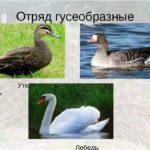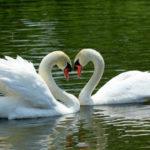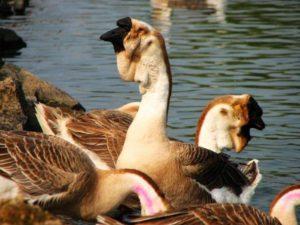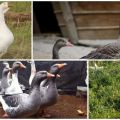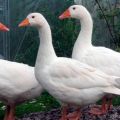How exactly do swans differ from geese, description and features of birds
In Russian folklore there is a fairy tale "Geese-Swans", in which those and other birds seem to be identified, merge into a single entity. Here they act as carriers of anxiety and danger, not related to the physical image of the characters. But is there something that distinguishes geese physiologically from swans? And what associations do these birds evoke in human consciousness?
Definition
It is quite scientifically possible to describe geese and swans with one general sentence: waterfowl of the order of anseriformes of the duck family. Latin names are different: Cygnus - swans, Anser - geese. It is worth taking a look at these members of the duck family separately.
Geese
Geese have devices for swimming: webbed feet, resembling flippers, and a sebaceous gland, with which they carefully lubricate their feathers from getting wet. Those who read the classics remember that in the old days there was no better lubricant for shoes than goose fat. Taking advantage of this advantage, birds live near water bodies: there the grass is juicier, and you can profit from high-calorie duckweed, and you can fish out something with a high protein content in a river, swamp or even the sea. Geese also feed on insects. Yet plant foods form the basis of their diet.
The goose is a large bird, especially if you do not take into account the predatory representatives of this class. The weight of the ancestor of domestic geese, a gray representative of wild relatives, ranges from 3-4.4 kilograms. Body length is slightly less than 1 meter. The wingspan is 1.5-1.8 meters. The powerful plumage of these limbs allows the birds to travel enormous distances. The large down layer improves the aerodynamic performance of the bird's rounded body and excellently retains heat. Geese fly to warm countries and back at high altitudes at night. There are cases of collisions of these birds with planes.
Swans
The swans are also supplied with a “beginner diving kit”. While holding their breath, they can compete with an experienced scuba diver. Plunging their heads into the water, they dig a hole up to 1 meter in diameter, simultaneously eating all living things that come their way. These are not only crustaceans, larvae, fish, but also the roots and young shoots of aquatic plants. Perhaps it is such labor achievements that give the swan such a proud posture.
The body weight of a mute swan, the fabulous beauty of which makes it stand out even against the background of its fellows, is 5.5-13 kilograms. The wingspan is up to 2.5 meters. Body length - up to 1.8 meters. Of the birds, only an owl can encroach on a swan.It is more often hunted by medium-sized terrestrial predators such as foxes.
How to tell a goose from a swan
Knowing how many similarities these birds have, it is still not difficult to determine who is who.
| Swan | Goose | |
| Posture | Slim, graceful | Stocky, squat |
| Body size | Large | 1.5-2 times less |
| Wingspan | Up to 2.5 meters | Smaller |
| Neck | Very long and thin | Much shorter and thicker |
| Color | Sometimes black | Gray and white like a swan |
| Where he prefers to be | In the pond | On the shore |
| Domestication | Wild | It happens at home |
| Couple | One for life | Different every year |
| In human nutrition | On the table of the nobility | For Christmas to the middle class |
| Vote | Mostly silent | Voiced shrill, heard even during the flight |
Human perception
For people, a swan is a symbol of beauty and fidelity. Everyone knows the Swan Princess from the fairy tale of Alexander Pushkin, from "Swan Lake" by PI Tchaikovsky. The majestic birds floating in the city gardens always attract spectators. Craftsmen make festive tableware in the shape of swans, recalling the royal feasts.
The wild goose is an attractive hunting object. The domestic goose raises concerns when it is alive and gets approval in the form of a gastronomic product. These are the relatives.




